“CANASTROMANIA”
Term for “basket fever” coined by Smithsonian curator Otis Mason, from the Latin word canistra, meaning basket (1904:187)
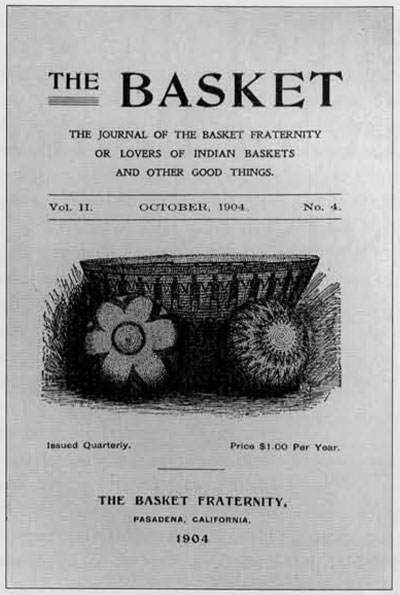
Issue in the collection of the Grace Hudson Museum, Ukiah, Cal. Photograph by Evan Johnson, 1997
Attracted by the beauty and romantic aura of Indian baskets, the United States was swept up in a veritable “basket craze” around 1890. Smithsonian curator Otis Mason commented that the fad “almost amounts to a disease,” a malady exhibiting a multitude of symptoms (1904:187). Decorating homes with Indian baskets and other Indian “curios” came into vogue; it became fashionable to “have a number of Indian baskets strewn around the parlor” (Frye 1977:58) supplying “a distinct charm that can be had from nothing else” (Lester 1906:68).
Collecting these Indian baskets became a popular pastime, “people of wealth vying with one another in owning them” (Mason 1904:ix). “Probably no other one hobby has been ridden so furiously,” proclaimed an 1895 article, and there is “perhaps none which faster `runs into money’ (Anonymous 1895:85). A collector of Indian baskets, often referred to at the time as a “basket crank,” purchased baskets directly from Native people, obtained them secondhand from dealers and curio stores, or traded pieces with other enthusiasts.
The early years of the 20th century also saw a rise in tourism. Prosperous, urban Americans traveled throughout the West in growing numbers, hoping to encounter not only the transcendent beauties of Nature, enshrined in such places as Yosemite Valley and Glacier Bay, but also exotic “Others”—American Indians. Transportation companies, such as the Santa Fe Railway, featured American Indians in their advertisements, and the promotional publications of several such companies specifically targeted Indian basket collectors. “Are you interested in basketry?” began a 1906 Pacific Coast Steamship Company brochure. “Tourists visiting Alaska via the ‘totem pole route,’ have the opportunity to purchase direct from the native makers, Baskets, Totems, and other curios at reasonable prices” (Gogol 1985:17).
Magazine articles promoted the fad, such as a 1896-piece in The Land of Sunshine entitled “Confessions of a Basket Collector,” or a 1901 article in Harpers Bazaar on “Indian Baskets as Decoration” (Connor 1896; Guthrie 1901). Indeed, a veritable flood of writings about Indian basketry appeared during this era, evidence of Americans’ fascination with the subject. Prominent national newspapers as well as smaller local papers, numerous and diverse popular periodicals, scientific journals, and museum publications all regularly carried pieces on Indian baskets, even including such doggerel as the following verse:
The Indian Basket-Maker
I weave my baskets; all the high and low Of my wild life in these wild stems I snare. The jagged lightning and the star I show. The spider and the trailing snake are there. And many a mystic thought doth shape and flow, Setting itself in picture firm and fair. (Anna Ball in Out West 16, no. 2 [19011:158)
During 1903-1904, George W. James, a “basket crank” par excellence, produced a magazine entitled The Basket (Fig. 1). It was the organ of The Basket Fraternity, a society organized to bring together “those who have felt the charm and fascination of Indian basketry” Games 1903).
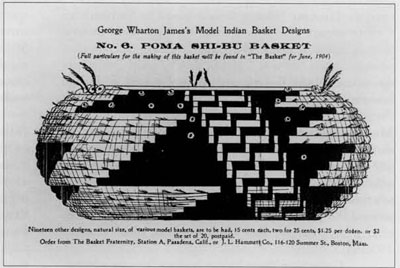
Original in the National Anthropological Archives, Smithsonian Institution, Washington, D.C. Photograph by Evan Johnson, 1997.
Groups such as the Becumtuck Basket Society of Deerfield, Massachusetts, existed nationwide. Their members, mostly women, admired, studied, and sometimes even replicated Indian baskets. A host of pamphlets and books provided such zealous weavers with instructions and patterns, including James’ volume on How To Make Indian and Other Baskets (1904), which utilized the Deerfield society’s “fined basketry” as examples (Fig. 2). Some of these enthusiasts went so far as to wear Indian-style garments and headdresses while being photographed with their handiwork or basket collections (Fig. 3). James neatly captured this form of “playing Indian” in his story of a White woman who became indignant when a friend did not sufficiently admire her “Indian” basket. “But it is not an Indian basket!” exclaimed the friend. “Certainly it is,” responded the wrathy weaver, “fir I made it myself” (James 1903:98; emphasis in the original).
The presence of American Indian basketry exhibits at numerous regional and national fairs and expositions provides additional testimony to the widespread public interest in Indian baskets. Private collectors as well as institutions such as the Smithsonian’s Bureau of American Ethnology, the American Museum of Natural History, and the Field Columbian Museum assembled and displayed collections of basketry at such events, hoping to attract visitors and educate the public. Often Native basket makers demonstrated their skills for fairgoers as part of such displays (Fig. 4).
“The Peer Among Curios from all the Barbaric Nations of the Earth”
Dr. John W. Hudson, describing Pomo basketry (1893:576).
In early articles, authors categorized Indian baskets by broad geographic regions; they made reference to Pacific Coast baskets’ or ‘Southwest baskets’. The appearance in 1884 of Helen Hunt Jackson’s novel Ramona, an immensely popular romance featuring California “Mission” Indians, resulted in a general public recognition of and desire for California Indian baskets, especially Mission baskets. There was, however, no national awareness of “Berno” baskets at this time. Smithsonian curator Mason’s 1884 survey of American Indian basketry, based on the collections of the National Museum, for example contained no mention of Berno basketry.
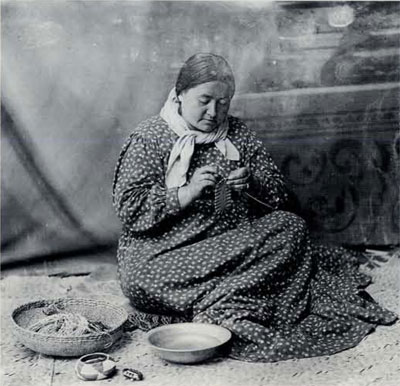
Photograph by Charles Carpenter. Courtesy of The Field Museum, Chicago, neg. 15111.
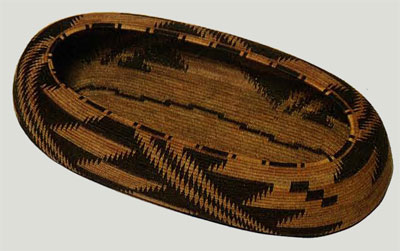
Photograph by F. Sarin
Museum Object Number: NA8237.
It was largely thanks to the efforts of one man, Dr. John Wilz Napier Hudson, that Berno baskets first became widely recognized as a type of Indian basketry, and began to acquire their well-deserved reputation for excellence. The young physician Hudson emigrated from Nashville, Tennessee, to the small northern California town of Ukiah, the seat of Mendocino County, in 1889. Soon after his arrival, he married Grace Carpenter, daughter of two of the area’s first White settlers.
The couple shared an interest in Native peoples. Grace Carpenter Hudson grew up among the Pomoan people who lived in the various Native communities around Ukiah. A talented painter, she became nationally famous for her numerous oil portraits of American Indian people. John Hudson had participated in various archaeological excavations in Tennessee. Once he arrived in Ukiah, he soon became acquainted with and interested in Pomoan peoples.
It is clear that John Hudson appreciated the beauty, craftsmanship, and commercial potential of Pomo baskets virtually from the day of his arrival in northern California. He treated a number of Indian patients, and his notes detailing cases and symptoms were soon interspersed with Pomoan vocabulary and drawings of basket designs. Hudson’s “Medical Log Book” (begun on April 5th, 1889) lists, for example, Native terms for different types and shapes of baskets, along with a series of Northern Pomo phrases, including “I wish a basket”; “What kind of a basket?”; “What kind of a basket do you want?”; “Sell, sell it!”; “Sell it under all circumstances”; “Give me that basket” (GHM, Notebook 22540, pp. 15, 295, 302).
Ukiah was a fortuitous location for Hudson’s future career in basketry (see Fig. 2 in Patterson, this issue). The town formed a natural hub for the commercial market in Pomo baskets, ringed as it was by five nearby Bemoan communities or “rancherias”: Yokayo Rancheria, Coyote Valley Rancheria, Pinoleville Rancheria, Mushtown (later called Guidiville Rancheria), and Potter Valley rancherias. These rancherias were communally owned by Bemoan peoples, and each boasted many fine weavers. In addition, the 1889 arrival of the railroad provided urban collectors and summer tourists from the San Francisco Bay area with a convenient link to this rural town. Stagecoaches regularly traveled between Ukiah and the western shores of Clear Lake further inland, where two other Pomoan communities were located. Habematolel (xaabe maath’olel at Upper Lake and the Mission Rancheria at Kelseyville were also known for their beautiful basketry (see McLendon, this issue).
Prior to her marriage, Grace Hudson had a small basket collection which decorated her studio. From this beginning, the Hudsons commenced systematically buying fine Pomo baskets. Only a few months after his marriage, John Hudson began corresponding with Otis Mason, asking advice on how to assemble and document a scientific collection of local baskets. Hudson’s medical practice dwindled as he spent more and more time buying Pomo baskets and studying Bemoan languages and cultures. By 1893, thanks largely to his efforts, the couple had amassed a remarkable collection (Fig. 5) containing over 300 Berno baskets.
At this time, John and Grace Hudson began to actively seek a buyer for their baskets; they had overextended themselves financially building the collection, and needed to realize a profit on their investment. They were thus materially interested in increasing the visibility and desirability of Pomo baskets among collectors. “We must sell or be busted,” John wrote to Grace in 1893, but remember, he cautioned, “We now have a monopoly in [Pomo] baskets and won’t give it up unless good money is paid for it” (GHM, Correspondence, to G. Hudson, 4358, 4361).
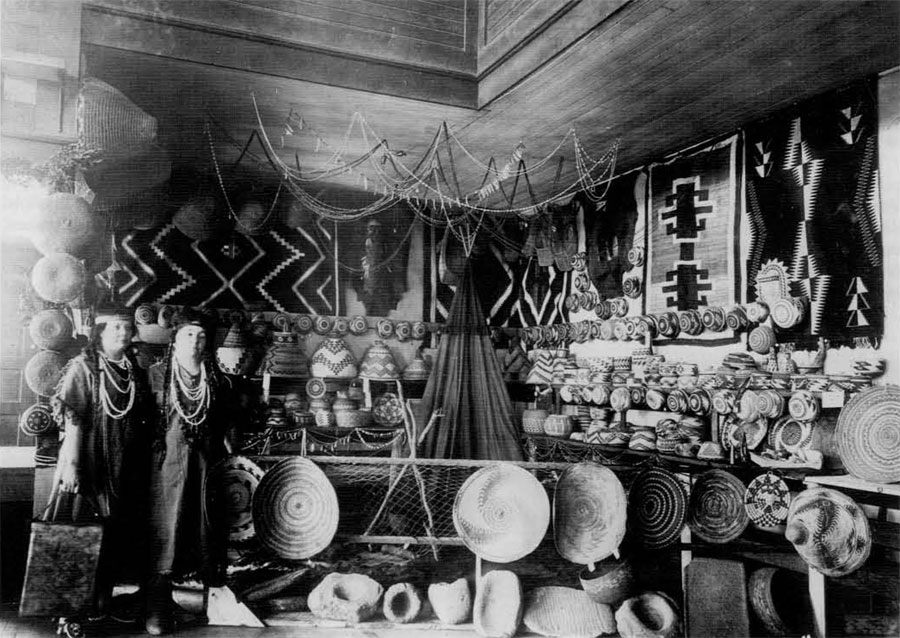
Unknown photographer, ca. 1900. Photograph courtesy of The Bancroft Library, Berkeley, Cal.
They first attempted to interest the Smithsonian Institution’s Bureau of American Ethnology (BAE) in purchasing their baskets. In the fall of 1892, BAE ethnologist Henry W. Henshaw visited the couple in Ukiah to examine the collection. He described it to his superiors as “a fine one,” but regretfully refused to buy, the Hudsons’ price being too high for the BAE’s budget (NAA, from Henshaw, 10/23/1892).
The Hudsons next attempted to market their baskets during the winter of 1893. They set up a display at the Mechanics’ Institute Industrial Exhibition in San Francisco, and let a few select, wealthy people know that they could be persuaded to let the collection go for the right remuneration. During the course of the Exhibition, the Hudsons’ collection generated a great deal of interest, admiration, and publicity, even garnering a gold medal.
At the close of the fair, however, it remained unsold. Shortly thereafter, in a calculated attempt to generate a demand for Bemo baskets which the sale of his collection would help supply, John Hudson wrote an article on Pomo basketry for the popular Overland Monthly magazine. Appearing in the summer of 1893 and entitled “Bemo Basket Makers,” Hudson’s piece was widely admired, and its publication cemented his reputation as an Indian basketry expert. It also succeeded in creating a much wider awareness of and desire for the beautiful baskets of Pomoan peoples.
The article, lavishly illustrated with Grace Hudson’s drawings of Bemoan peoples and photographs of baskets from the Hudson’ collection, was the first extensive examination of Pomo baskets ever published (Fig. 6). In it Hudson enthused over the beauty and fineness of Pomo basketry, “that delicate, beautiful fab Eric which consumes months, and even years in completing” (1893:562). He described and named—in the Northern Pomo language—the basic materials and weaving techniques utilized by Pomoan peoples, along with characteristic types of Pomo baskets and their traditional uses. Hudson’s Anglicized names for weaving techniques—terms such as tee, bomtoosb, shuset, shy boo, and tsy—quickly became the standard terminology for referring to all Pomo basketry, not just that of Northern Pomo peoples. Indeed, this terminology came to be used, in early literature, to refer to the basketry of many other Indian groups as well.
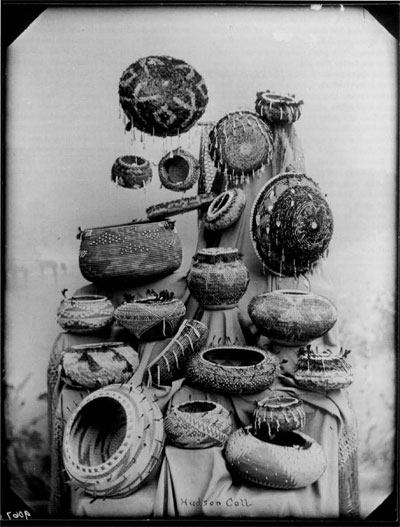
Photograph by A.O. Carpenter, ca. 1893. Courtesy of the Grace Hudson Museum, Ukiah, Cal.
Hudson’s article painted Bemoan peoples and their baskets with a romantic brush. Erroneously describing all Bemo baskets as produced by a single peaceful tribe from Better Valley, “[the] most primitive Indian[s] now in America,” Hudson cautioned that collectors should immediately search out these splendid baskets since “their equals will probably never be seen, for their makers are now on the eve of final departure” (1893:564, 576).
Thus, at the outset of the early commercial Indian basket market, Pomo baskets were invested with an aura of scarcity, a common ploy used by sellers everywhere to persuade buyers of the investment value of their merchandise. Contrary to Hudson’s dire prediction, Bemoan peoples began weaving baskets at an unprecedented rate, and of unsurpassed quality, to take advantage of the new and welcome commercial opportunity.
At the height of this market, in the period from 1890 to 1920, virtually every Bemoan woman made baskets to be sold to Whites, some on a part-time basis, some nearly full-time. In 1901, for example, Coyote Valley Rancheria resident Will Duncan wrote a newsy letter to Grace Hudson, describing many of his female relatives as “all right” and “making basket.” He went on to tell her that “in Pinoleville [Rancheria] they are making basket every day and night” (GHM, Correspondence, to G. Hudson, 21400).
While Pomoan weavers and White dealers both profited from the market that John Hudson did much to create and expand, the Hudson themselves were unsuccessful in selling their collection until 1899, six years after the publication of “Pomo Basket Makers” in the Overland Monthly. The Hudsons’ collection of some 326 baskets was purchased by the Smithsonian Institution for $3260, an average price of $10 per basket, sizably reduced from the earlier asking price of $5,000 at the 1893 San Francisco exposition.
The sales contract required that John Hudson write a descriptive catalogue of the collection. He spent many months at this task, and Otis Mason congratulated him on the result. Indeed, Mason wrote an article for American Anthropologist summarizing Hudson’s catalogue and hailing the collection as the “best scientific collection of basketry known to the writer from any people on earth” (1900:346).
The publicity surrounding the Smithsonian’s purchase of the Hudson’ collection ignited a competition among other major American museums, such as the American Museum of Natural History, the Brooklyn Museum, the Field Columbian Museum, and the Milwaukee Public Museum, to acquire similar collections of Pomo basketry. Their number included the University of Pennsylvania Museum of Archaeology and Anthropology which eventually purchased the Patty Stuart Jewett, Plimpton, and Deisher basket collections (see Berman, this issue). And so the Pomo masterworks contained in these collections came to rest in Philadelphia, far from the northern California homelands of their creators, now to be admired anew by today’s audiences.
Gogol, John M., 1895. “1900-1910, The Golden Decade of Collecting Indian Basketry.” American Indian Basketry 5(1):12-29.
Guthrie, Jane W., 1901. “Indian Baskets as Decoration.” Harpers Bazaar 35:468-71.
Hudson, John W., 1893. “Pomo Basket Makers.” The Overland Monthly 21(126):561-78.
James, George Wharton, 1904. How to Make Indian and Other Baskets. 2d ed. Pasadena, Cal.: Printed privately by the author. Reprinted, 1970, with Aboriginal Indian Basketry (Glorieta, N.M.: The Rio Grande Press).
James, George Wharton, ed., 1903. The Basket: The Journal of the Basket Fraternity or Lovers of Indian Baskets and Other Good Things. Vols. 1 and 2.
Lester, Francis E., 1906. Indian and Mexican Handicraft: Fifth Annual Catalogue of the Francis E. Lester Company. Mesilla Park, N.M.: The Francis E. Lester Company.
Mason, Otis T., 1884. “Basketwork of the North American Aborigines.” Report of the U.S. National Museum: 291-306.
——-, 1900. “The Hudson Collection of Basketry.” American Anthropologist 2(1):346-53.
——-, 1904. “Aboriginal American Basketry: Studies in a Textile Art Without Machinery.” In Annual Report of the U.S. National Museum, Smithsonian Institution, 1902. Pp. 173-548. Reprinted, 1970, as Aboriginal Indian Basketry (Glorieta, N.M.: The Rio Grande Press).
NAA, National Anthropological Archives, Bureau of American Ethnography, Correspondence, National Museum of Natural History, Smithsonian Institution, Washington, D.C.
